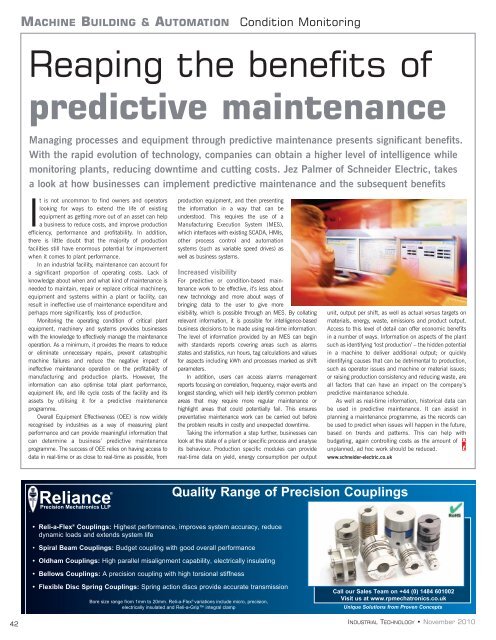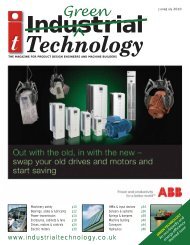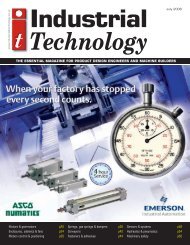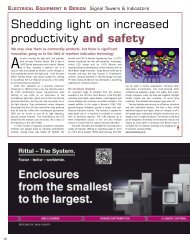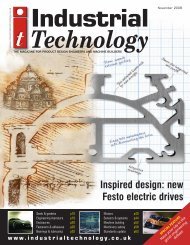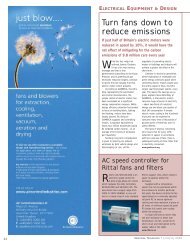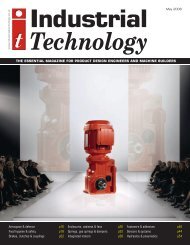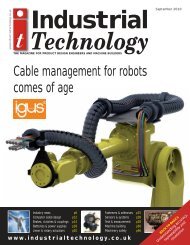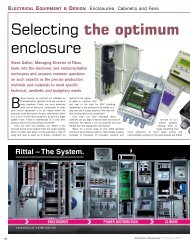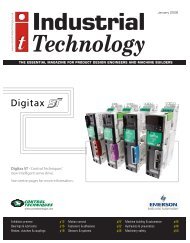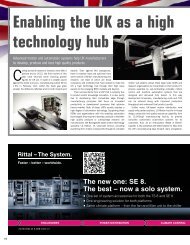machine building & automation - Industrial Technology Magazine
machine building & automation - Industrial Technology Magazine
machine building & automation - Industrial Technology Magazine
- No tags were found...
Create successful ePaper yourself
Turn your PDF publications into a flip-book with our unique Google optimized e-Paper software.
MACHINE BUILDING & AUTOMATIONCondition MonitoringReaping the benefits ofpredictive maintenanceManaging processes and equipment through predictive maintenance presents significant benefits.With the rapid evolution of technology, companies can obtain a higher level of intelligence whilemonitoring plants, reducing downtime and cutting costs. Jez Palmer of Schneider Electric, takesa look at how businesses can implement predictive maintenance and the subsequent benefitsIt is not uncommon to find owners and operatorslooking for ways to extend the life of existingequipment as getting more out of an asset can helpa business to reduce costs, and improve productionefficiency, performance and profitability. In addition,there is little doubt that the majority of productionfacilities still have enormous potential for improvementwhen it comes to plant performance.In an industrial facility, maintenance can account fora significant proportion of operating costs. Lack ofknowledge about when and what kind of maintenance isneeded to maintain, repair or replace critical <strong>machine</strong>ry,equipment and systems within a plant or facility, canresult in ineffective use of maintenance expenditure andperhaps more significantly, loss of production.Monitoring the operating condition of critical plantequipment, <strong>machine</strong>ry and systems provides businesseswith the knowledge to effectively manage the maintenanceoperation. As a minimum, it provides the means to reduceor eliminate unnecessary repairs, prevent catastrophic<strong>machine</strong> failures and reduce the negative impact ofineffective maintenance operation on the profitability ofmanufacturing and production plants. However, theinformation can also optimise total plant performance,equipment life, and life cycle costs of the facility and itsassets by utilising it for a predictive maintenanceprogramme.Overall Equipment Effectiveness (OEE) is now widelyrecognised by industries as a way of measuring plantperformance and can provide meaningful information thatcan determine a business’ predictive maintenanceprogramme. The success of OEE relies on having access todata in real-time or as close to real-time as possible, fromproduction equipment, and then presentingthe information in a way that can beunderstood. This requires the use of aManufacturing Execution System (MES),which interfaces with existing SCADA, HMIs,other process control and <strong>automation</strong>systems (such as variable speed drives) aswell as business systems.Increased visibilityFor predictive or condition-based maintenancework to be effective, it’s less aboutnew technology and more about ways ofbringing data to the user to give morevisibility, which is possible through an MES. By collatingrelevant information, it is possible for intelligence-basedbusiness decisions to be made using real-time information.The level of information provided by an MES can beginwith standards reports covering areas such as alarmsstates and statistics, run hours, tag calculations and valuesfor aspects including kWh and processes marked as shiftparameters.In addition, users can access alarms managementreports focusing on correlation, frequency, major events andlongest standing, which will help identify common problemareas that may require more regular maintenance orhighlight areas that could potentially fail. This ensurespreventative maintenance work can be carried out beforethe problem results in costly and unexpected downtime.Taking the information a step further, businesses canlook at the state of a plant or specific process and analyseits behaviour. Production specific modules can providereal-time data on yield, energy consumption per outputunit, output per shift, as well as actual versus targets onmaterials, energy, waste, emissions and product output.Access to this level of detail can offer economic benefitsin a number of ways. Information on aspects of the plantsuch as identifying ‘lost production’ – the hidden potentialin a <strong>machine</strong> to deliver additional output; or quicklyidentifying causes that can be detrimental to production,such as operator issues and <strong>machine</strong> or material issues;or raising production consistency and reducing waste, areall factors that can have an impact on the company’spredictive maintenance schedule.As well as real-time information, historical data canbe used in predictive maintenance. It can assist inplanning a maintenance programme, as the records canbe used to predict when issues will happen in the future,based on trends and patterns. This can help withbudgeting, again controlling costs as the amount ofunplanned, ad hoc work should be reduced.www.schneider-electric.co.uk®ReliancePrecision Mechatronics LLPQuality Range of Precision Couplings• Reli-a-Flex ® Couplings: Highest performance, improves system accuracy, reducedynamic loads and extends system life• Spiral Beam Couplings: Budget coupling with good overall performance• Oldham Couplings: High parallel misalignment capability, electrically insulating• Bellows Couplings: A precision coupling with high torsional stiffness• Flexible Disc Spring Couplings: Spring action discs provide accurate transmissionBore size range from 1mm to 20mm. Reli-a-Flex ® variations include micro, precision,electrically insulated and Reli-a-Grip integral clampCall our Sales Team on +44 (0) 1484 601002Visit us at www.rpmechatronics.co.ukUnique Solutions from Proven Concepts42INDUSTRIAL TECHNOLOGY • November 2010


